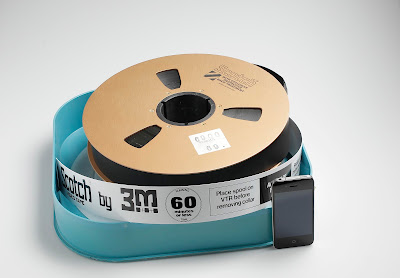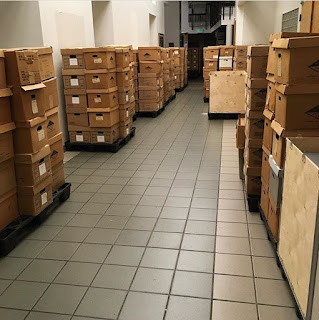 |
| Quad Tape, soon to appear at a nonprofit regional archive near you. |
Tick-tock! Time is running out for videophiles to enjoy the glitchy, retro pleasures of analog media. Last year, the last videocassette recorder (VCR) was manufactured in Japan, and preservation experts recommend migrating VHS and other types of analog video to digital formats within 10 to 12 years. Langsdale Special Collections has been caring for two major audiovisual news morgues: the WMAR collection and the WJZ collection, which both consist of raw footage and broadcast materials from the two local network-affiliated television stations.
While the WMAR collection will still be cared for and accessible here at University of Baltimore, we’re going to maximize our efforts with regards to preserving the WJZ collection by working with the donor (WJZ-TV) and a newly formed nonprofit, the Mid-Atlantic Regional Moving Image Archive (MARMIA.) This will help to ensure the future of the delicate ephemera that makes up the WJZ audio and visual repository– ¾ tapes, quad tapes, 16mm footage, and VHS tapes, among other formats.
 |
| 1,000 boxes of vintage WJZ-TV are ready to roll! |
To date, University of Baltimore has contributed to this collaboration by housing the collection in approximately 1,000 spiffy archival-grade boxes and inventorying the collection items, box by box. We’ve also digitized several hundred videos, which will be transferred to MARMIA along with the analog holdings.
There is no broadcast format more evocative of the past than the quadruplex videotape (commonly known as the “quad tape”), which were in vogue for filming and broadcasting purposes from the 1950s to the the early 70s. They are among the most fragile of video media, and equipment with which to play them– huge decks that look like something out of a kitschy 1960s SciFi movie–are mostly extinct.
Recently, Langsdale Library digitized more than two terabytes of open reel quad tapes, footage that will further preserve and provide access to the WJZ archive. Metadata and Digital Curation Librarian Maggie Dull coordinated this effort, which was generously funded by the UB Foundation. That this long-unseen mystery footage will see be unveiled for the first time in more than 40-plus years is something we’re all excited about.
| Celebrating WJZ-TV’s Preservation! (raw footage courtesy of the WMAR-TV collection) |
Truth be told, moving 1,000 archival boxes is a bit of a slog. Special Collections staff members carefully packed and palletized the collection over a course of weeks in preparation for its transfer to MARMIA, which has partnered with the Maryland State Archives to store the collection at the Baltimore City Archives. UB also contributed all available descriptive tape inventories, a collection database record, and over 100 previously digitized video recordings, all to orient new users to the analog treasures they will discover in the collection.
While Langsdale will miss having the WJZ collection here at UB, we’re delighted to have a hand in making sure the collection is well cared for and accessible, as well as working with other area archives who love local history as much as we do.

